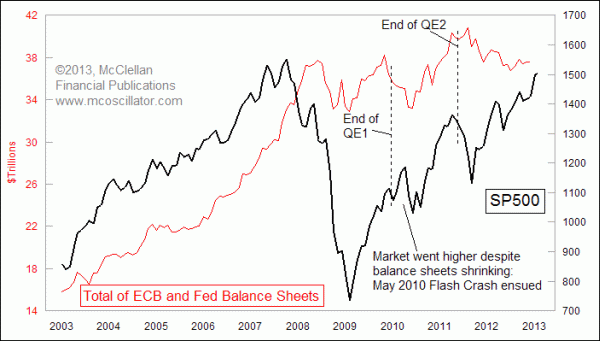ECB’s Shrinking Balance Sheet

Free Chart In Focus email
Delivered to you every week
The news this week out of Europe has to do with upcoming elections in Italy, and what that might mean for the future of the euro. But few news stories are covering the really important development in Europe, which is the shrinking size of the European Central Bank (ECB) balance sheet.
The U.S. Federal Reserve has been doing its part to inflate the banking system, most recently with its announced program to purchase $40 billion per month of mortgage backed securities (MBS). But the Fed's total balance sheet size of $3.02 trillion pales in comparison to the size of the ECB's €26 trillion balance sheet, which equates to $34.6 trillion as of December 2012. While the Fed's holdings have increased 6.7% since the September 2012 Jackson Hole conference, the shrinkage of the ECB's balance sheet over that same time period has more than made up for the Fed's money printing.
The reason why this is important is because there is a very strong correlation between the combined size of the ECB and Fed balance sheets and the movements of the world's stock markets. When the balance sheets are growing, that is overwhelmingly a bullish factor for stock prices.
When balance sheets stop growing or start shrinking, it is a little bit more complicated. Past episodes of shrinking balance sheets in 2008, 2010, and 2011 all were associated with big drops in the SP500 and other indices. As 2013 gets underway, the SP500 is continuing higher and challenging its 2007 all-time high, but it is doing so in an environment when the combined balance sheet size has not been rising.
This creates a bit of an analytical quandary. Is this stock market strength with no balance sheet rise a sign that the stock market and the world economy are finally able to proceed on their own, and without central bank stimulus? Or is this just another example of what we saw in early 2010, when the stock market continued higher for a few months after the faucet was turned off?
In that 2010 example, what resulted was the Flash Crash in May 2010, and a lower bottom in July 2010, after which the stock market started upward again when the Fed announced its QE2 program, and when the ECB jumped in with similar monetary stimulus. So to bet on the hypothesis that the stock market can now fly on its own is to say "it's different this time", which is one of the more dangerous phrases for investors to ever utter.
Tom McClellan
Editor, The McClellan Market Report
Apr 13, 2012
Fed and ECB Balance Sheets |
Sep 21, 2012
Unemployment to Turn Up in 2013 |
Jun 29, 2012
Interest Rate Models Call For Lower Dollar |